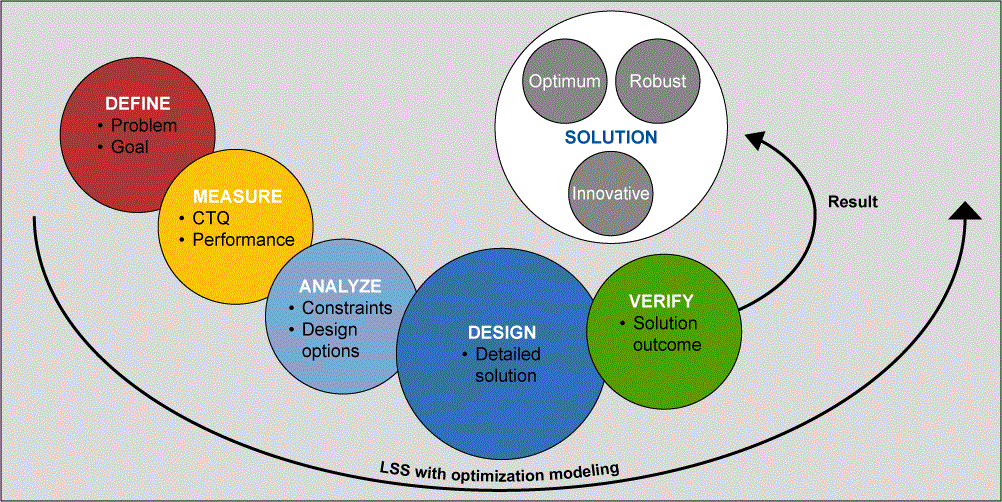
“Speed is survival.” That could be called the mantra for all manufacturing and service organizations in today’s uncertain and continuously changing global economy. In this example, a leading manufacturer of color picture tubes (CPTs) was posed with a survival challenge: to improve manufacturing productivity. By adopting Lean Six Sigma methods, the manufacturer was able to increase speed and, thus, improve productivity and throughput capacity.
As depicted in Figure 1, this case study illustrates the application of operations research techniques (optimization modeling) in a Lean Six Sigma DMADV project to identify, validate and roll-out optimum, robust and innovative solution which helped the CPT organization to improve throughput capacity and productivity.
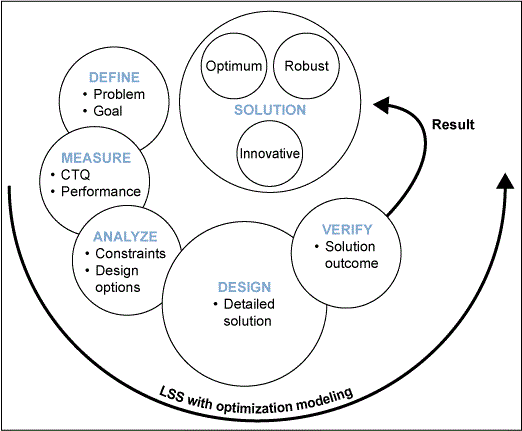
In this operation, part of the CPT manufacturing process involves a process know as frit sealing. The process attaches the glass faceplate to the glass funnel section of the tube with a mixture of raw glass material called “frit,” which is heated in a multistage gas-fired furnace to make a hermetic seal. Figure 2 shows the setup of the manufacturer’s frit-sealing furnace, which is 30 meters long.
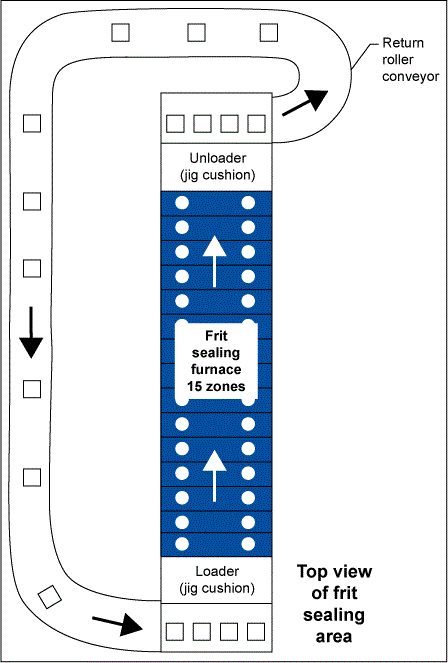
Figure 3 shows the original top and front view of the CPTs as they are loaded on a frit-sealing holding apparatus, know as a “jig,” as they enter the furnace.
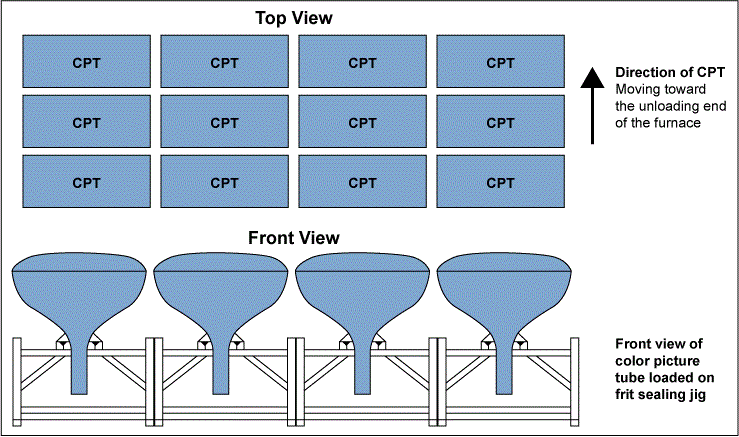
Each zone of the furnace is temperature-controlled as required by a frit-sealing temperature profile. Four CPTs in a row are loaded on frit sealing jigs and pass inside the furnace on a conveyor belt. The glass panels of the CPTs are placed over a frit-paste-coated glass funnel. The frit then melts inside heating zones of the furnace (Figure 4) and crystallizes to seal together the edges of the glass panel and funnel. Frit-sealed CPTs are then unloaded from the furnace and moved forward for further processing.
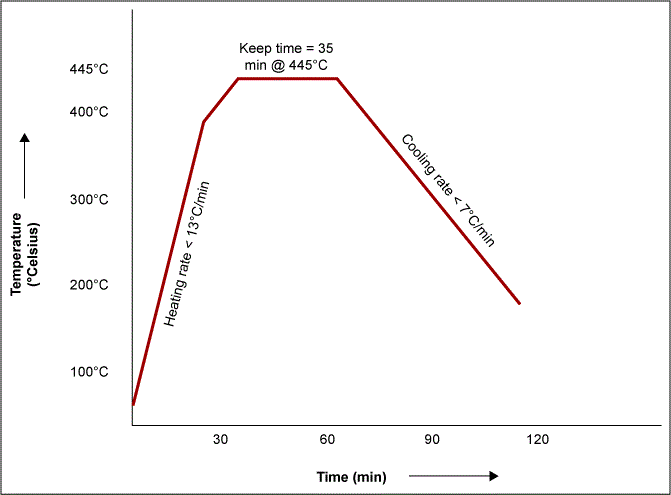
Define?
Due to falling CPT market prices and its profitability, management at the CPT manufacturer deduced that, if the production throughput capacity of the CPT facility was not increased by at least 50 percent, it would not be viable to continue operation. Hence, management initiated a program for enhancing CPT throughput capacity with a target to increase mass production capacity by 50 percent to reduce the operational cost of making CPTs.
As part of the capacity expansion program, the goal of the Lean Six Sigma project was to increase the throughput capacity of the process from 1.2 million CPTs per year to 1.8 million per year. The scope of the project was limited to the frit-sealing process and its associated production units.
Measure
The critical-to-quality measure for this project is takt time or line index (denoted by “i”). Takt time is the time gap between productions of each CPT.
Throughput capacity (C) can be calculated as:
C = Duration in a year * % Utilization * % Process Yield
Takt Time (i)
At a production capacity of 1.2 million CPTs per year, the manufacturer had a process yield of 85 percent and production system utilization of 93.75 percent. The frit sealing furnace was operated at a takt time/index of 20.8 seconds. The target of the project was to reduce takt time to the specification limit of ? 14 seconds and, thereby, increase the velocity of the manufacturing line without altering process yield and line utilization.
Takt time (i) can be mathematically derived as follows:
1) Length of furnace (L) = frit sealing processing time (Tp) x velocity (V)
2) Pitch of jig (p) = Time to cover one pitch (t) x V
3) t = number of CPTs in a row inside frit-sealing furnace (N) x Takt time (i)
From the above equations:
i = Tp x p
N x L
Optimization Model
Using operations research integer programming techniques, the following is the optimization model to optimize the frit-sealing capacity expansion problem:
Subject to constraints:
- L = 30 m – There is no space available to increase the furnace length for further capacity expansion.
- Tp ? 104 min. – There is no process margin left to cut down processing time below 104 minutes for capacity expansion.
- P ? 0.4 m – There is no gap between the 21-inch CPTs for pitch of less than 0.4 meters along the width of the CPTs, as per initial jig design.
- 1 < N ? 4 – There is no gap between the 21-inch CPTs along the length of the CPT.
- i ? 14 sec. – As per the project’s objective, takt time should be less than 14 seconds.
Decision variables:
- The number of CPTs in a row inside the frit-sealing furnace (N) – integer variable. Initially, N= 4.
- Pitch of jig (p). Initially, p = 0.4 meters.
Analyze
Based on the constraints on the optimization model, there is no scope of any reduction of takt time as the values of the each of the parameters (L, Tp, p, N) are at their extreme limits.
In such a scenario, an innovative idea was generated to break the constraints for capacity expansion. Due to conical shape of the CPT funnel, the pitch, width and length of the frit-sealing jigs can be reduced by overlapping CPTs with adjacent CPTs on the front, rear and same rows of CPTs.
So, there are two options:
1) Pitch can be reduced by 0.065 m. As a result, the revised constraint is p ? 0.335 meters; OR
2) The number of jigs in a row can be increased to six. As a result, the revised constraint is 1 < N ? 6.
However, the above two ideas cannot co-exist together, meaning that if the number of CPTs in a row are increased, then pitch cannot be reduced and vice-versa.
Hence,
p ? 0.335 m, if and only if N = 4
OR
1 < N ? 6, if and only if p = 0.4
Solution
Based on the revised constraints, Table 1 provides the solution space which meets the 14-second takt time requirement.
Table 1: Solution Analysis
No. of jigs/CPTs in a single row (n) |
Pitch (p) (meters) |
Length of furnace (meters) – constant |
Frit-sealing processing time (min.) – constant |
Takt time (project Y) in seconds |
Remarks |
Select Option |
| 4 | 0.4 | 30 | 104 | 20.80 | Initial state | No |
| 4 | 0.335 | 30 | 104 | 17.42 | More than 14 sec. takt time | No |
| 5 | 0.4 | 30 | 104 | 16.64 | More than 14 sec. takt time | No |
| 5 | 0.335 | 30 | 104 | 13.94 | N and p cannot be changed simultaneously | No |
| 6 | 0.4 | 30 | 104 | 13.87 | Viable solution, as it satisfies all constraints | Yes |
| 6 | 0.335 | 30 | 104 | 11.61 | N and p cannot be changed simultaneously | No |
The only solution which meets the 14-second takt time requirement is N= 6 and p= 0.4 meter, as seen in Figure 5.
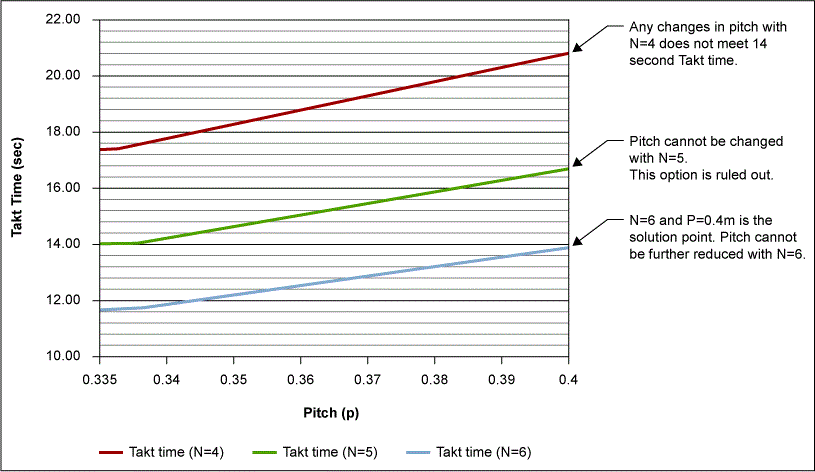
Design
The diagram in Figure 6 depicts the change with N = 6 and p = 0.4 meters. In this figure, six CPTs are loaded onto frit-sealing jigs. Taller and smaller jigs are altered to provide the overlap in a given row. There is no overlap between CPTs in the front rows of CPTs.
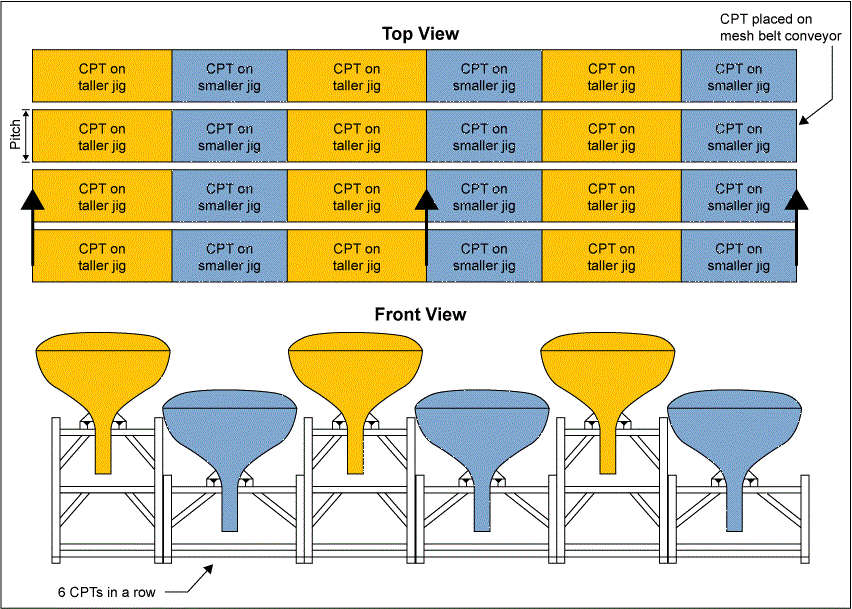
Prototypes of the smaller and taller jigs were created and tested. Based on the solution concept, frit-sealing jigs were redesigned with computer-aided designing (AutoCAD) tools.
The following are the key changes made to the frit-sealing jigs:
- A reduction of the length of the jig by 0.0825 meters.
- An overlapping of the CPTs, which was achieved by lowering the height of one frit-sealing jig and increasing the height of an adjacent jig.
- Redesigning the spacers and chains on the loaders and unloaders (jig cushions) to load and unload six CPTs from furnace. As a mistake-proofing measure, adding proximity sensors before CPT loading to ensure the correct sequence of jigs.
Verify
Prototypes of the frit-sealing jigs were created and successfully tested on the running furnace to test all the quality parameters of the frit-sealing process.
The benefits from the innovative design of the frit-sealing jigs included:
- Furnace extension cost savings totaling $1 million to meet frit-sealing capacity expansion requirements.
- Saved cost of production downtime of 10 working days by saving a production of frit-sealing worth 33,000 CPTs. Frit-sealing capacity expansion requirement of 1.8 million CPTs per year, as part of the larger capacity expansion program.
Through the use of optimization modeling aids, all capacity constraints at the CPT manufacturer were conquered. The solution improvements helped the facility meet its desired throughput capacity.